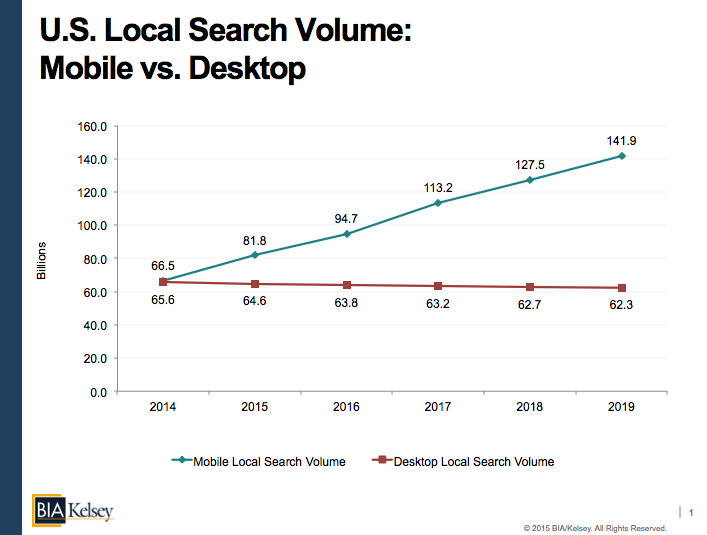
Google has made lots of waves in tech and media worlds with last week’s revelation that mobile search volume now outweighs desktop. That goes for several developed markets including the U.S. This follows recent LSA data that show mobile has surpassed desktop for local-intent search.
These are two different measures but directionally similar. With mobile local queries, the point at which they surpass desktop was bound to be earlier than overall mobile search, given that local’s share of mobile search (about 50 percent) is higher than the desktop equivalent (about 20 percent).
We’ve been saying for quite some time that 2015 would be the year that mobile local query volume surpasses desktop local query volume, which turned out to be on target. Here’s our projection from April 2012.
We now believe based on lots of evidence and inputs that the intersecting point actually happened late last year. Adjusting to that reality and looking forward from the current period. Our forecast released last month projects mobile local search query volume as follows.
Google’s announcement last week shows that the growth of mobile search is even more pronounced. That intersecting point of mobile and desktop search isn’t just happening with local queries as shown above, but in overall search too. This is huge.
This is of course a milestone in the continued growth of mobile content. But it’s really only one indicator. As I often say when presenting mobile data, search is only one format through which mobile content and ads are distributed. It’s currently the biggest… but it’s only one.
Discovery Channel
In the relatively short history of the smartphone, search has been in a battle with discovery-based content such as apps, push alerts and social sharing. The latter, as it grows in organic usage, is likewise increasingly becoming an ad vehicle — starting national but very much moving local.
Meanwhile Google, with a commanding search market share, has the most to lose from this. Impressively, it’s not showing signs of succumbing to the classic innovators dilemma in terms of embracing “discovery” based media. This can be seen in Google Now and lots of other things.
Google knows that the future of search is both active and passive. For the latter, apps like Google Now will perpetually search on users’ behalf to proactively push “results” when pre-defined relevance thresholds (such as geofence) are triggered.
Watch Carefully
The passive discovery format will only grow with the (still questionable) advent of wearables, where the user experience is even less conducive to typing search queries (voice search will find a home). So it will be all about discovery a la Google Now, and push notifications.
It will be interesting to watch (pardon the pun) this unfold with respect to user tolerance levels. Push notifications will require a careful balance given that the nuisance risk is greater on the sacred territory of one’s wrist, as opposed to the ignorable phone in their pocket.
This is all being built as we speak, and requires lots of experimentation for pinpointing the right delivery formula that resonates with users. No one has found that yet. But we do know, as always, that wide-scale changes in form factor invite volatility and entry points for disruption.




This Post Has 0 Comments